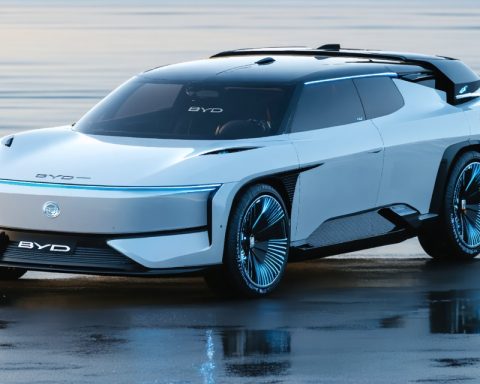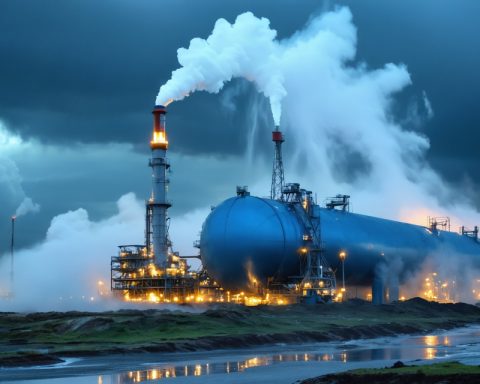- TotalEnergies and Air Liquide announce a €600 million joint venture for green hydrogen production using wind energy.
- A 250-megawatt electrolyzer will be built in Zeeland, Netherlands, to reduce emissions at TotalEnergies’ refinery.
- A 200-megawatt electrolyzer is planned near Rotterdam to support TotalEnergies’ Antwerp plant with green hydrogen.
- The Zeeland plant commissioning is expected in 2029, and the Antwerp facility aims for 2027 completion.
- Projects could collectively prevent up to 500,000 tons of CO2 emissions annually, enhancing sustainability.
- Integration with existing hydrogen pipeline networks suggests broader sustainable energy adoption in the region.
A new chapter unfolds in Europe’s quest for sustainability as TotalEnergies and Air Liquide commit to a monumental €600 million joint venture. This bold initiative aims to harness wind energy to produce green hydrogen, setting the stage for a significant transformation in energy consumption at TotalEnergies’ refinery in the Netherlands.
Envision a colossal 250-megawatt electrolyzer, tirelessly drawing power from the relentless winds swirling around Zeeland. This technological marvel will fuel TotalEnergies’ decarbonization efforts, striving to transform its industrial operations. It’s more than just a project; it’s a pivotal step toward reducing emissions and a symbol of change as TotalEnergies pushes the boundaries of what’s possible with low-carbon hydrogen.
Meanwhile, Air Liquide is gearing up to build a 200-megawatt electrolyzer near Rotterdam, dedicated to powering TotalEnergies’ Antwerp plant with clean, green hydrogen. This dynamic alliance, fuelled by shared vision and innovation, marks a decisive move towards a greener future.
Commissioning of the Zeeland plant is anticipated in 2029, while the Antwerp facility targets an earlier start in 2027. Even before finalized investments, the impact of this project is amplified by Air Liquide’s rigorous planning and integration with existing hydrogen pipeline networks. These networks promise to serve a broader array of customers across the Netherlands and Belgium, suggesting a ripple effect of sustainable energy adoption.
Upon fruition, these ambitious ventures could prevent the release of up to 500,000 tons of carbon dioxide annually. As the wind whispers through the Dutch coast, it carries with it the promise of change—a beacon of hope for a cleaner, sustainable tomorrow.
How This Massive Wind-Hydrogen Project Could Change Europe’s Green Energy Landscape
How-To Steps & Life Hacks for Green Hydrogen Use
1. Understand Electrolysis: Green hydrogen is produced by splitting water into hydrogen and oxygen using electricity from renewable sources. For individual consumption, consider small-scale electrolysis kits available for educational purposes.
2. Feasibility Assessment: For businesses, assess if integrating green hydrogen technologies can reduce your carbon footprint. This typically involves detailed analysis of energy needs and existing infrastructure compatibility.
3. Explore Partnerships: Follow TotalEnergies and Air Liquide’s model by forming strategic alliances with industry leaders. Collaboration can help overcome financial and technical barriers.
Real-World Use Cases of Green Hydrogen
– Refining & Petrochemicals: As demonstrated in the TotalEnergies project, green hydrogen can decarbonize industrial processes, mainly by replacing fossil fuels in energy-intensive industries.
– Transportation: Hydrogen fuel cells are promising for buses, trucks, and potentially aircraft, offering lower-emission alternatives to diesel and jet fuel.
– Energy Storage: Hydrogen can store excess renewable energy, such as wind and solar, addressing intermittent supply issues.
Market Forecasts & Industry Trends
The global green hydrogen market size was valued at USD 0.3 billion in 2020 and is projected to expand at a CAGR of over 54% from 2021 to 2030 (Grand View Research). Europe is poised for significant growth fueled by ambitious net-zero targets and supportive policies like the European Green Deal.
Reviews & Comparisons
Hydrogen vs. Other Energy Sources:
– Efficiency: Hydrogen has a higher energy content by weight than batteries but is less efficient in terms of energy losses during conversion and storage.
– Sustainability: Unlike natural gas, hydrogen can be produced without CO2 emissions if renewable energy is used.
Controversies & Limitations
– Energy Input: Green hydrogen production is energy-intensive; it requires significant renewable electricity, which competes with other uses.
– Cost: Currently, green hydrogen is more expensive than hydrogen made from natural gas due to high production costs.
Features, Specs & Pricing
– Electrolyzer Capacity: 250 MW in Zeeland and 200 MW in Rotterdam.
– Pricing: While specific project costs aren’t publicly detailed beyond the €600 million investment, the cost of hydrogen production can range between $3 to $7 per kg, with anticipated reductions as technology and scale improve.
Security & Sustainability
– Energy Security: Diversifies energy sources and reduces dependency on fossil fuels.
– Environmental Impact: Could prevent up to 500,000 tons of CO2 emissions annually, aligning with global climate goals.
Insights & Predictions
– Infrastructure Expansion: Anticipate growth in hydrogen pipeline networks, enhancing distribution efficiency and integration.
– Policy Development: With mounting interest, expect more favorable regulations and subsidies that support hydrogen projects.
Tutorials & Compatibility
– Grid Integration: Transitioning to hydrogen involves integrating with existing energy systems, requiring compatibility assessments for power grid connections and hydrogen storage solutions.
Pros & Cons Overview
Pros:
– Reduction in industrial carbon emissions
– Versatile energy applications
– Aligns with global efforts towards sustainability
Cons:
– High initial investment
– Technological maturity required
– Possible geopolitical resource distribution issues
Actionable Recommendations
1. Adopt a Green Energy Strategy: Position your business to leverage green hydrogen technology, particularly in manufacturing and transportation.
2. Stay Informed on Policy Shifts: Monitor government incentives and policy shifts that can support hydrogen technology’s integration in various sectors.
3. Invest in Research & Development: Focus on technological advancements to improve green hydrogen production efficiency and cost-effectiveness.
For further insights into hydrogen technologies, you can visit Air Liquide or TotalEnergies.

















